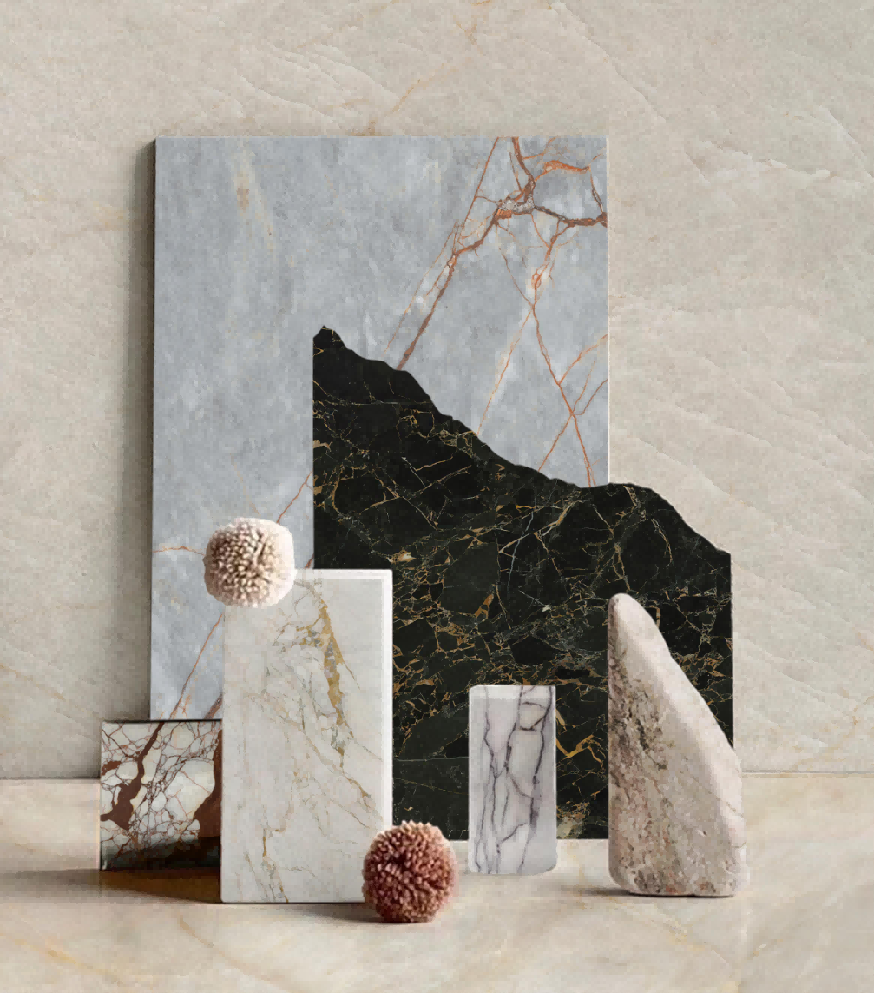The Difference between porcelain slab and porcelain Tile
Although both porcelain slabs and Porcelain tiles are used as decorative building materials, there are significant differences between them in terms of raw materials, production processes, and performance applications.
In terms of raw materials, the porcelain slab is primarily composed of natural minerals such as quartz, feldspar, and basalt, without any organic materials and with a high alumina content, exhibiting a 100% recyclable environmental feature. In contrast, porcelain tiles mainly use clay as their primary material, the recycling rate of these tiles is only 30%-50%.

The differences in production processes directly determine their physical properties. The porcelain slab is pressed using 18000-36000 ton ultra-high press machine, with a density of over 3.6g/cm³, and can be made into ultra-thin or ultra-thick sheets of 6-12mm. It is then continuously burned at a high temperature of 1180℃ for 60-120 minutes to form a dense and stable structure. porcelain tiles, on the other hand, rely on presses ranging from 2000 to 8000 tons for shaping, with a density of 2.3-2.5g/cm³ and a conventional thickness of 9-20mm. The firing temperature is slightly lower (1130℃) and the time is shorter (53 minutes).
In terms of surface treatment, the porcelain slab achieves wear and scratch resistance with a Mohs hardness of 6-7 through the combination of digital inkjet and full body technology. porcelain tiles, on the other hand, mostly use glazed printing or polishing processes, with a Mohs hardness of 4-6 and weaker resistance to scratches. Furthermore, the porcelain slab supports irregular cutting and curved processing, with a maximum size of up to 3.2×1.6m, while porcelain tiles are prone to breakage due to their high brittleness, with a conventional size of only 0.6x1.2m.
| Property | Porcelain Slabs | Ceramic Tiles |
| Raw Material | High-purity selected raw materials (high whiteness) | Primarily clay, with lower purity requirements; some contain glaze |
| Production Process | Ultra-high pressure + prolonged high-temperature firing + advanced processes | Standard pressing + conventional firing |
| Physical Performance | Superior cutting/workability, outstanding wear/anti-stain resistance |
Poor workability, lower hardness, higher water absorption |
| Applications | High-demand applications (countertops, walls, furniture) | General decoration (floors, walls) |

The performance differences further delineate their application scenarios. The porcelain slab, with its high hardness, extremely low water absorption rate (<0.1%), and high temperature resistance, is widely used in high-end countertops, furniture finishes, background walls, and outdoor architecture. porcelain tiles, with their lower hardness, are mostly used for floor tiling and conventional wall decoration. Although both have similar stain resistance and water absorption rates (both <0.1%), the porcelain slab's production process is more complex and costly, resulting in a significantly higher price than porcelain tiles.
In summary, if you pursue design, durability, and environmental protection, the porcelain slab is the preferred choice for high-end spaces. If you focus on economy and practicality, porcelain tiles can meet basic decorative needs. When purchasing, it is necessary to consider budget, scene requirements, and material performance to achieve the best use effect.

Whether you're working on a high-end residential kitchen or a hotel lobby, understanding the difference between porcelain slabs and tiles can help you make the right choice. For more product details or samples, feel free to contact KITO CERAMICS.
wechat/whatsapp: 0086-13923140006 or [email protected]
👉 Learn more: Porcelain Slab What's Porcelain Slab?

